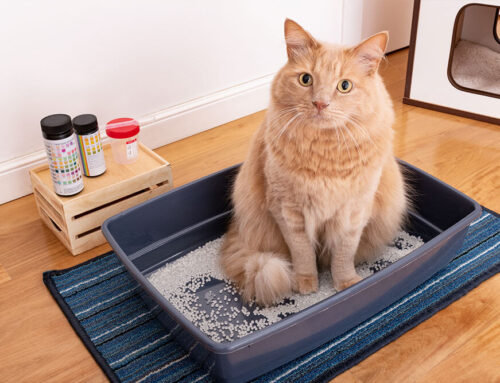Chronic kidney disease (CKD) is a common progressive condition that affects dogs and cats. Sadly, most pets don’t begin to show signs of illness until 75% of their kidneys are destroyed, resulting in the need for more intense supportive care and reduced survival times.
Fortunately, a new screening test is available at the Animal Clinic of Council Bluffs that can identify CKD in its earliest stages, allowing us to delay its progression, and give affected pets a better quality of life.
What is chronic kidney disease in pets?
Chronic kidney disease is a progressive, incurable condition that occurs when a kidney’s microscopic functional units (i.e., nephrons) wear out. Experts estimate that a healthy dog or cat kidney contains hundreds of thousands of nephrons, which regulate the blood by reabsorbing vital properties and excreting waste, byproducts, and excess compounds (e.g., vitamins, minerals, electrolytes) as urine. These nephrons do not regenerate after damage or death, resulting in the gradual loss of kidney function for affected pets.
What causes chronic kidney disease in pets?
Although inherited causes exist (e.g., abnormally developed kidneys), age is the most common cause of CKD in pets. As pets reach their senior years, their hard-working nephrons start to wear out, resulting in decreased filtration abilities. Instead of directing waste and byproducts to the bladder for elimination, the dysfunctional kidneys allow these harmful substances to reach toxic levels in the blood—ultimately affecting the entire body.
What are chronic kidney disease signs in pets?
Early CKD signs are vague and can be dismissed as age-related changes. By the time your pet displays more obvious signs, at least two-thirds of their nephrons have been destroyed. At that point, progression is rapid and may be unalterable. Signs from mild to severe include:
- Weight loss
- Dull coat
- Bad breath
- Decreased appetite
- Increased urination
- Increased thirst
- Urinary accidents
- Lethargy
- Nausea
- Vomiting
- Diarrhea
- Seizures
In addition to filtering waste from the bloodstream, the kidneys are also responsible for regulating internal pH and blood pressure, and producing key hormones involved in red blood cell production and calcium balance. As a result, any signs of damage may be seemingly disconnected or generalized.
How does early detection benefit pets?
Although there is no cure for CKD, its signs (e.g., nausea, weight loss, increased thirst, appetite loss) can be controlled with supportive veterinary care. Depending on a pet’s disease stage, these measures can enhance their quality of life and extend their survival time. The later your pet is diagnosed, the less likely they will be to respond to therapeutic interventions.
Early detection allows your pet to live longer and better by identifying a specific kidney biomarker in their blood known as symmetric dimethylarginine or SDMA. When combined with traditional blood work, SDMA elevations can detect chronic kidney disease when only 40% of the kidney is impaired—compared to two-thirds with traditional diagnosis. Early detection allows for more rapid and effective intervention, which can slow nephron deterioration and help your pet live longer and better with their disease.
How will the veterinarian screen my pet for CKD?
The SDMA test is a simple blood test that is paired with your pet’s annual wellness blood work (i.e., complete blood count—or CBC—and general chemistry profile). Although inherited CKD causes can strike pets as young as 3 years old, the Animal Clinic of Council Bluffs team recommends yearly SDMA testing for all dogs and cats over 7 years old.
What happens if my pet’s SDMA test results are elevated?
If your pet’s SDMA results exceed the normal range, additional testing or ultrasound imaging will be necessary to confirm the diagnosis and determine the stage of their kidney disease (e.g., mild, moderate, or severely affected).
If your pet is diagnosed with early CKD, our veterinary team will design a management plan to support and preserve their current kidney function. This typically includes several different strategies to ease the workload on the nephrons and slow their deterioration. Common management strategies for early CKD include:

- Therapeutic kidney diet — Veterinary formulated diets with low sodium, phosphorus, and acid but moderate protein are easier on the kidneys while delivering complete and balanced nutrition.
- Increased hydration — Pets with CKD are chronically dehydrated because their kidneys release excess water. Options for increasing water intake include pet water fountains, soaking dry food in warm water, or feeding wet (i.e., canned) food.
- Addressing underlying causes — If your pet’s CKD is secondary to another condition such as a congenital defect, infection, cancer, or kidney stones, their treatment will include medications and therapies to address or manage these problems.
- Monitoring — Frequent follow-up visits to your veterinarian will be used to monitor your pet’s kidney function and stay ahead of the disease’s progression.
As your pet’s condition worsens, additional therapies will be incorporated, such as subcutaneous fluids, medications to bind excess calcium and phosphorus in the blood, reduce nausea, and stimulate appetite.
How can I support my healthy pet’s kidney function?
Chronic kidney disease can’t be entirely prevented. However, you can promote proper kidney function in healthy pets by ensuring adequate hydration, avoiding high sodium foods, and staying up to date on your pet’s wellness care—including annual blood work—at the Animal Clinic of Council Bluffs. Contact our team to schedule your pet’s next appointment.






Leave A Comment